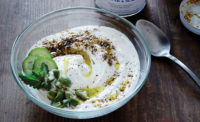Flavored yogurts, enhanced milk are the top dairy trends

As consumers pay more attention to their health, yogurt and enhanced milk are topping dairy product trends, according to “What’s in Store 2012,” the annual trends report compiled from more than 150 sources by the International Dairy-Deli-Bakery Association, Madison, Wis.
Yogurt dollar sales rose 7% to $5.2 billion in the food/drug/mass channel in the 52-week period ended May 14, 2011, according to Nielsen. In 2010, Americans ate yogurt 7.5 times per month on average, up from 7 times per month in 2006, Mintel reported.
Greek yogurt smoothies, new fruity flavors and yogurt can be substitutes for sour cream, mayonnaise and cream cheese in recipes. Some of the newer flavors are Cappuccino yogurt with almond crisp, orange yogurt with sea buckthorn, maple, and strawberry rhubarb.
Craft yogurts are also trendy in the dairy case. Since 2005, 30% of new product launches in the category have been craft products, which tout their milk sources and traditional processes. Enhanced milk is one of the new offerings in the dairy case that offers consumers more health options. Aside from vitamin milk concocted with special blends to cater to children, teens and women, there are also milk blends of cows’ milk and nut milks. Processors sell milk in flexible squeeze pouches with a screw tops that make it fun for children to drink.
Protein-rich milks with added vitamins are popular, as are meal-replacement shakes and sleep-provoking beverages that contain milk, soy, valerian root extract and melatonin. Milk tops the list of food purchased most often because of an added benefit or fortification.
“Better-for-you” and “better-for-the environment” are top dairy messages as consumers lean toward products with natural nutritional properties, functional additives, and sustainably produced actions.
Dairy products make up 14.6% of organic food sales, second to the fruit and vegetable category, which commanded 39.7% of the market. Organic dairy product sales rose by 9% in 2010 to total $3.9 billion according to the Organic Trade Association. Euromonitor projects the U.S. dairy market will grow to $53 million by 2015, up 5.2% from 2010.
Consumers average 34.8 dairy department shopping trips per year. More than half of these shopping trips include multiple items from the dairy case.
“What’s in Store 2012” includes department sales, per capita consumption, consumer preferences, and random-weight, UPC, and private label sales data. The full report is available from IDDBA for $99 (member price) and $399 (non-members), plus shipping and handling. To order, call the IDDBA Education Department at 608-310-5000 or visit the organization’s website, www.iddba.org.
Looking for a reprint of this article?
From high-res PDFs to custom plaques, order your copy today!



